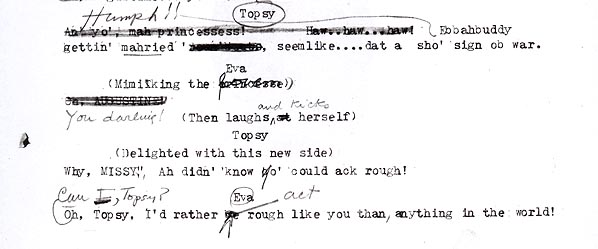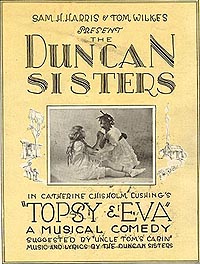

| Neither Catherine Chisholm Cushing, who wrote it, nor Rosetta and Vivian Duncan, who performed in it for over two decades, ever published a script of Topsy and Eva: A Comedy to be Played with Music. But in late October, 1923, Cushing sent a typescript of the play to the Library of Congress for the purpose of securing copyright. When she mailed off the script, the Duncans were starring in the show during its opening run in San Francisco, though on October 28th, the day after the typescript was received by the Library, the Duncans left during a contract dispute with producer Thomas Wilkes, and were replaced by the White Sisters, who were "Topsy" and "Eva" for the production's last two weeks in San Francisco and first two weeks in Los Angeles (for more, see John Sullivan's essay TOPSY AND EVA PLAY VAUDEVILLE). The text available here is a digitization of the script Cushing put in the mail, but it seems likely that her decision to copyright this text was a result of the contractual uncertainties surrounding the show rather than a sense that the text was "done." Cushing's script mixes sentiment and slapstick in ways that 1920s audiences would have been very familiar with. It spends a surprising amount of time on the tried and true storyline involving foreclosure and recovery, young love and marriage, but audiences probably never saw the play exactly as this script presents it. Although the Duncan Sisters are assigned very little dialogue, Rosetta was famous for her improvisational skills; much of her performance would not have ever been scripted. And the typescript itself indicates how the script was continually undergoing revsion. As you can see from the image above of a page from Act 3, even the "Copyright Copy" contains many pencilled changes. Programs in the archive from various productions, 1923 - 1942, indicate how the Duncans continued to revise and update the play with new songs and musical numbers. (For example, according to a notice in The San Francisco Examiner, "I Never Had a Mammy" was introduced into the entertainment on 6 October 1923; this song, which became one of the show's themesongs, is not mentioned in the typescript.) At the same time, however, those programs indicate that for almost two decades, the Duncans did stick with Cushing's retelling of Stowe's story, which eliminates slavery as any kind of problem. The happy ending is achieved when Mrs. Shelby can say "her slaves" are legally "hers" — there is no hint that any of them, not even George Harris (renamed "Geegee" here), see anything wrong with belonging to her. Stage directions refer unselfconsciously to "nigger faces" and "picks" (i.e. "pickaninnies"). There is a lot of banter about the differences between "Northern" and "Southern" men and women, but a unanimous longing to go "BACK TO THE PLANTATION!" as George Shelby puts it in Act 2. The digital text incorporates the pencilled revisions, but includes notes that indicate some of the passages in the typescript that were cancelled by the changes. |
 |
Left: 1924 Play Program Cover Courtesy John Sullivan. |
